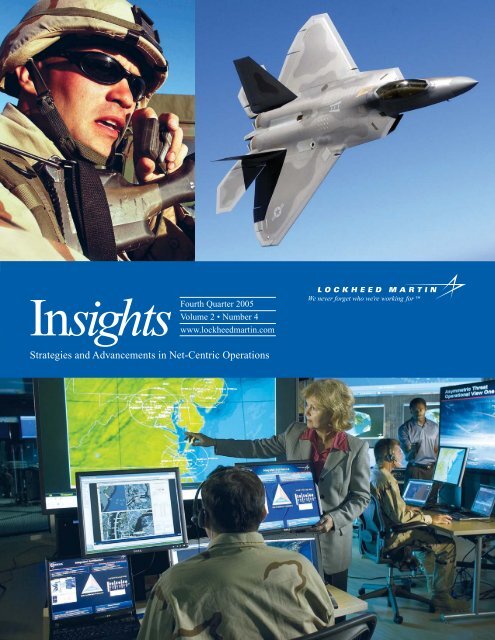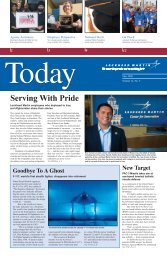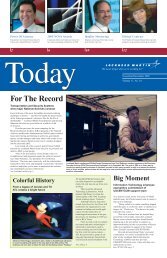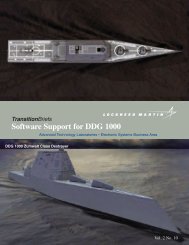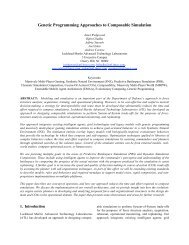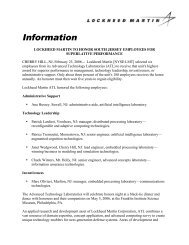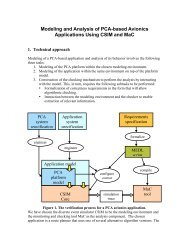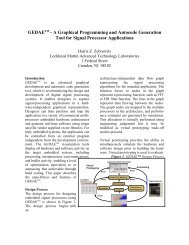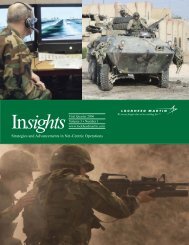Download pdf version of Ontology article - Lockheed Martin ...
Download pdf version of Ontology article - Lockheed Martin ...
Download pdf version of Ontology article - Lockheed Martin ...
Create successful ePaper yourself
Turn your PDF publications into a flip-book with our unique Google optimized e-Paper software.
InsightsFourth Quarter 2005Volume 2 • Number 4www.lockheedmartin.comStrategies and Advancements in Net-Centric Operations
Web’s PowerUNLEASHING SEMANTICWeb’s PowerTed CampbellVice President andManaging Director,C3 & InformationOperations<strong>Lockheed</strong> <strong>Martin</strong>A feature <strong>of</strong> Semantic Web technology is its ability to access data and informationby its content and capabilities and not through keyword search engines. ASemantic Web would enable computers to “talk” to other computers and linktogether domains –– domains <strong>of</strong> knowledge and domains <strong>of</strong> interest, such as C4ISR,sensors, weapons –– to compile and analyze large databases <strong>of</strong> information andgenerate new knowledge from them. Semantic Web technologies will identifyweb-based data by their interrelationships, generate logical connections amongthem, and thus make information searches more precise and effective –– a refinedsearch engine that returns with only that one desired answer.Insights • Page 12
“Harnessing COMPUTER STRENGTH supportshuman knowledge management EFFORTS.”Considered the Rosetta Stone <strong>of</strong>the information age, the SemanticWeb will undergo realistic network-centricdemonstrations at <strong>Lockheed</strong><strong>Martin</strong>’s Center for Innovation. Challengingnational defense scenarios are beingstructured for Semantic Web command andcontrol applications over the next few years.These combat-like exercises will involvecutting-edge information technologies inthe hands <strong>of</strong> skilled individuals with strongoperational experience.What <strong>Lockheed</strong> <strong>Martin</strong> envisions areSemantic Web technology demonstrationsthat will grow into high-risk, high-pay<strong>of</strong>fcapabilities to solve difficult impedimentsleading to operational dominance.The concept is to determine how command,control, communications, computers,intelligence, surveillance and reconnaissancecan evolve with Semantic Webtechnologies to meet challenges <strong>of</strong> newmobile targets, hostile environments andasymmetric warfare.A key ingredient in achieving operationaldominance is rapid sensor exploitationwith precision target identification andbirth-to-death tracking. If commandsystems are too slow to “connect the dots,”it will not be possible to kill mobiletargets by rapid, decisive action.Dynamic command and control is necessaryto support advanced weapon sensors,guidance and communications. Synergyis unfeasible unless information integrationis shared among various systems.Collaboration among people and machinesis the sine qua non for a rapidlyexpanding universe <strong>of</strong> sensors, weaponsand platforms.The Semantic Web: Creatinga “Web <strong>of</strong> Knowledge”One salient element, and a big advantage,in <strong>Lockheed</strong> <strong>Martin</strong>’s Semantic Webdemonstration planning, is the integration<strong>of</strong> engineers and operators to jointly solveproblems. Teams will be composed <strong>of</strong>former military people, including commanders,and highly skilled technicians,both young and old.The purpose <strong>of</strong> these demonstrations is toemploy Semantic Web technologies thatsupport soldiers at a checkpoint, sailors ata weapon station onboard a ship, andcommanders maneuvering to a position <strong>of</strong>advantage on the battlefield.Continued on Page 14.Insights • Page 13
Web’s Power“The key is machine-to-machine DATA interaction,compilation and analysis <strong>of</strong> large databases — even generation<strong>of</strong> new KNOWLEDGE inferred from them.”Continued from Page 13. solving real-world problems that are, inturn, scalable. This especially is the casewhen they hold the promise <strong>of</strong> bringingsituational awareness to combat commandersand their staffs.A commander must determine thedegree <strong>of</strong> risk and must, therefore, haveconfidence in the data. Assurance inthe information reduces uncertainty,and <strong>Lockheed</strong> <strong>Martin</strong>’s challenge is inbringing Semantic Web technologies tobear to do this. This thorny task requiresthe use <strong>of</strong> people who at some point intheir lives have been responsible formaking pr<strong>of</strong>ound decisions. Withouttheir involvement, this program mightmiss the mark.Now is the time to move Semantic Webtheory and technology out <strong>of</strong> the researchlaboratory and into practical applicationexperiments. Building ontologies would bedifficult without a healthy interaction <strong>of</strong>operators and engineers, communicatingwhat they are willing to allow a system toaccomplish. This is precisely the approachthat <strong>Lockheed</strong> <strong>Martin</strong> plans to take to itsCenter for Innovation. The Semantic Webis ubiquitous and the development <strong>of</strong>demonstration plans transcend commandand control systems by adding requirementsfor the intelligence and logisticscommunities, as examples.The Semantic Web: A HighlyCompetitive DevelopmentEnvironmentAs discussion <strong>of</strong> Semantic Web developmentcontinues, the technologies aremoving into the mainstream and accelerating.Use <strong>of</strong> semantic products holdsgreat promise to meet <strong>Lockheed</strong> <strong>Martin</strong>customer requirements. However, it iscritically important not to oversell thesetechnologies, to start out trying to bat athousand. Indeed, even if Semantic Webcapabilities only average 250 or 300, it isimperative to chip away at development,Semantic Web development is a highlycompetitive landscape. Most expertiseresides in the research and developmentcommunity — small companies andacademia, such as MassachusettsInstitute <strong>of</strong> Technology, Stanford andthe University <strong>of</strong> Maryland. Moreover,large aerospace and defense contractorsare beginning to participate in burgeoningprograms; using Semantic Web productsfor applications to imagery, databasemanagement and visualization s<strong>of</strong>tware.European companies, especially in Germanyand France, are investing approximately300 million Euros ($370 million)in Semantic Web technology programs,which they call the Semantic Grid.The majority <strong>of</strong> this work is aimed atcommercial and industrial uses, notdefense applications.The value <strong>of</strong> the Semantic Web to industry,and <strong>Lockheed</strong> <strong>Martin</strong>, is obvious. There are,for instance, programs with values in theInsights • Page 14
illions <strong>of</strong> dollars that could make quickuse <strong>of</strong> Semantic Web technologies. Awindow <strong>of</strong> opportunity exists to creatediscriminating competitive advantages.Sufficient Semantic Web technologiesare available for demonstration purposes.Leveraging this expertise could quicklyalign developments and provide criticalmass.The Semantic Web:Driven by Urgent DoD NeedsIn using Semantic Web technologies for avariety <strong>of</strong> defense programs, a majorlogistics initiative with business-drivenapproaches is a pressing example that<strong>of</strong>fers an immediate company benefit.Another is the Army Knowledge On-Lineprogram. With more than 1.8 million usersworldwide, AKO is the premier webgateway to the Army enterprise. Thesophisticated web portal gives soldiersfast, easy access to dozens <strong>of</strong> logisticsand combat support applications, securee-mail and messaging, and volumes <strong>of</strong>valuable information.The AKO Enterprise Services programinvolves a $152 million contract awardedto a <strong>Lockheed</strong> <strong>Martin</strong>-led team earlierthis year. The program calls for a singlecontractor team to take over managementand administration <strong>of</strong> AKO, developingand implementing a strategic plan forcutting costs, streamlining operationsand improving service to warfighters.Semantic Web technologies could play avital role in this effort.The Department <strong>of</strong> Defense is rapidlymoving from circuit-based to InternetProtocol-based networks, to vastlyincrease and improve the use <strong>of</strong> bandwidth.Today’s focus is on mobile networks,especially ad hoc networks withvoice over IP, as the internet goes to war.Emerging joint concepts <strong>of</strong> operationsrequire interfacing command and controlwith modeling and simulation systems.Underpinning joint concepts is the digitalfusion <strong>of</strong> operations, intelligence, logisticsand their command and control systems.Data standardization is proving toodaunting for DoD, forcing anotherapproach — communities <strong>of</strong> interest thatContinued on Page 16.Advances Drive Web’s TransitionCutting-edge information technology research for the World Wide Web is directed towardexploiting the data on the web by linking facts. Formal knowledge structures, or ontologies,are being developed and added via markup languages to make the web machine processable.Until recently, the web has been primarily about presenting documents and data to people —a revolutionary hypertext web <strong>of</strong> data. Still, current web technology is not machine-processable,which, unless changed, cannot support critical defense community components <strong>of</strong>command, control, operations, logistics and intelligence.The HyperText Transfer Protocol is the underlying protocol used by the web to define howmessages are formatted and transmitted, and what actions web servers and browsers shouldtake in response to various commands.But this is now changing with the advent <strong>of</strong> the Semantic Web, to create a knowledge-basedweb –– a “web <strong>of</strong> facts” that can be understood by both man and computers.Semantic Web research and activity develops specifications for technologies that are readyfor large-scale deployment, and identifies infrastructure components through open sourceand proprietary advanced development. Principal technologies <strong>of</strong> the Semantic Web fit intoa set <strong>of</strong> layered specifications.The goal <strong>of</strong> the semantic initiative is to create a universal medium for exchanging data, wheredata can be shared and processed by automated tools as well as by people, according tothe World Wide Web Consortium, or W3C.For the web to scale, tomorrow’s programs must be able to share and process data, evenwhen these programs have been designed totally independently. The Semantic Web will dothis –– smoothly interconnecting personal information management, enterprise applicationintegration, and the global sharing <strong>of</strong> commercial, scientific and cultural data.Facilities to put machine-understandable data on the web are quickly becoming a highpriority for organizations, individuals and communities, W3C has emphasized.• Web <strong>Ontology</strong> Language, or OWL, enables Semantic Web machine readability withvery rich semantics to support web-based s<strong>of</strong>tware for: intelligence analysis andproduction; military planning and operations; s<strong>of</strong>tware agents for command, control,communications, computers, intelligence, surveillance and reconnaissance; andsensor fusion.• OWL makes it possible to build ontologies in a language understood by bothhumans and machines. Ontologies present data as a triple statement — subject,predicate and object.• OWL-Services, or OWL-S, provide a standard set <strong>of</strong> ontologies that allow s<strong>of</strong>twareagents to perform automatic discovery <strong>of</strong> a desired service through its pr<strong>of</strong>ile. Thispr<strong>of</strong>ile is held in a web registry where service requests are matched to advertisedservices. OWL-S is the web services description language.• OWL is emerging from development with orders-<strong>of</strong>-magnitude improvements insearch and discovery — to automatically extract information from text and enablethe straightforward integration <strong>of</strong> numerous disparate databases.Insights • Page 15
Web’s PowerContinued from Page 15.will self organize themselves to standardsand reduce the complexity <strong>of</strong> datastandardization.Clearly, the direction the defense communityis headed is toward a concept<strong>of</strong> services and registries, and that iswhere Semantic Web technology applicationswill have impact.Interfacing operational command andcontrol with real-time engagementcapability demands that planningand fire control systems communicate.Ubiquitous Semantic Web technologiesare at the core <strong>of</strong> this goal.The Semantic Web brings to the WorldWide Web the concept <strong>of</strong> having datadefined and linked in a way that it canbe used for more effective discovery,automation, integration and reuseacross various applications.This vision is to make data on theSemantic Web machine-readable, allowingcomputers to integrate information fromdissimilar sources. By augmenting datasources and web pages with descriptions<strong>of</strong> the content they hold, it is possible toreason about that content.The Semantic Web:W3C Brings OrderWithout Semantic Web capability, currentweb technologies search and examine onlyabout 25 percent <strong>of</strong> potentially relevantsites. Web searches return a lot <strong>of</strong> unwantedinformation, and much information on theweb is not suitable for s<strong>of</strong>tware agents.As the web continues to expand, problemsintensify. The web developed topsy-turvyand almost overnight as a documentorientedmedium for humans, not fordata and information systems capable <strong>of</strong>automatic processing. Semantic Webtechnology is designed to reverse theselimitations.Sir Tim Berners-Lee, one <strong>of</strong> the principalarchitects <strong>of</strong> the World Wide Web, alsoproposed the idea <strong>of</strong> the Semantic Web.From his work, disparate networks werelinked by the common HTTP protocols andHTML data format, transforming packetswitching computers on multiple networksinto the World Wide Web.While evolutionary and still in their infancy,the future <strong>of</strong> Semantic Web technologieswould appear bright. Nevertheless, thereis little consensus over the likely directionand characteristics <strong>of</strong> the Semantic Web.Still, the World Wide Web Consortium,or W3C, a dedicated group working toimprove, extend and standardize thesystem, claims that many semantic languages,publications and tools havealready been developed.The W3C views the Semantic Web as amesh <strong>of</strong> information linked up in such away as to be easily processable by machineson a global scale. The Web <strong>Ontology</strong>Language, or OWL, is viewed as an efficientway <strong>of</strong> representing data on theWorld Wide Web, or as a globally linkeddatabase. Semantics correlate the meanings<strong>of</strong> words and language to make knowledgegrouping more efficient, opening the wayto net-centric concepts, such as automateddata searches and tracking.The key is machine-to-machine datainteraction, compilation and analysis <strong>of</strong>large databases — even generation <strong>of</strong>new knowledge inferred from them.The Semantic Web:The Intelligent, Intuitive WebWhat appears to be at stake withSemantic Web development is anenormous impact — nothing less thanreinventing the global computing infrastructure.Evolution <strong>of</strong> Semantic Webtechnology enables building applicationsthat could expand with exponentialspeed.Just over a year ago, the W3C issuedfinal approval <strong>of</strong> two key Semantic Webtechnologies: the revised ResourceDescription Framework, RDF, and theOWL. RDF and OWL are Semantic Webstandards that provide a framework forasset management, enterprise integration,sharing and reuse <strong>of</strong> data on the web.RDF is an infrastructure that enables theencoding, exchange and reuse <strong>of</strong> structuredmetadata. It imposes necessary structuralconstraints to provide unambiguousmethods <strong>of</strong> expressing semantics. Additionally,RDF provides a means for publishingboth human-readable and machineprocessablevocabularies. This technologyis designed to encourage the reuse andextension <strong>of</strong> metadata semantics amongdissimilar information communities.OWL is a formal language that representsknowledge through the use <strong>of</strong> ontologies.These describe concepts and relationshipsand enable knowledge sharing and reuse.OWL helps applications process thecontent <strong>of</strong> information instead <strong>of</strong> justpresenting information to humans. Thislanguage facilitates greater machineinterpretability <strong>of</strong> web content by providingadditional vocabulary along with aformal semantics (See <strong>article</strong>, “AdvancesDrive Web’s Transition,” on page 15).Insights • Page 16
These standard formats for data sharingspan application, enterprise and communityboundaries, so that all different types <strong>of</strong>users can share the same information, evenif they do not share the same s<strong>of</strong>tware.The W3C’s approval marked the emergence<strong>of</strong> the Semantic Web as a broad-based,commercial-grade platform for data on theweb. Deployment <strong>of</strong> these standards incommercial products and services signalthe transition <strong>of</strong> Semantic Web technologyfrom largely research and advanced development,to more practical applicationsdeployed as mass-market tools. These toolsenable more flexible access to structureddata on the web.The Semantic Web:Reinventing the GlobalComputing InfrastructureIt was a government-funded research effortheaded by the Defense Advanced ResearchProjects Agency –– the DARPA AgentMarkup Language, or DAML –– that hashelped advance the state-<strong>of</strong>-the-art forthe Semantic Web and help transition itfrom the laboratory to practical applicationsas tools.Features <strong>of</strong> OWL are based on machinereadability with very rich semantics. OWLsupports agents for intelligence analysisand production, military planning andoperations, C4ISR and sensor fusion. OWLbuilds upon existing internet frameworks,HTML and XML, which are already beingadopted widely by the military, to providemeaningful information to s<strong>of</strong>tware agents.Sets <strong>of</strong> linked ontologies are at the heart <strong>of</strong>OWL; tools have been developed to buildSemantic Web systems.Vast military and worldwide commercialinterest exists in OWL because <strong>of</strong> W3C’sacceptance. Specifically designed todescribe ontologies in a distributed webenvironment, OWL is the technicalfoundation for a Semantic Web revolution.Alignment Algorithms Vital<strong>Lockheed</strong> <strong>Martin</strong> is embarking on a technical journey that could have pr<strong>of</strong>ound effectson worldwide military and industrial communities. At stake is rebuilding the World WideWeb through sophisticated technologies that harness computing power to fully supporthuman knowledge.<strong>Lockheed</strong> <strong>Martin</strong>’s Advanced Technology Laboratories is concentrating on concepts tominimize the user’s involvement in the creation and management <strong>of</strong> ontologies as muchas possible. An area <strong>of</strong> ATL’s focus is broadly known as ontology alignment or ontologymapping. This development effort over the past several years has provided tools toreconcile semantic differences between ontologies. One highly successful prototype inthis area is called Ontrapro, the <strong>Ontology</strong> Translation Protocol.Ontrapro is a data model alignment architecture designed to provide key semanticintegration capabilities. It automatically delivers semantic alignments between elementsin vastly different data models; this allows translation between diverse commandand control, modeling and simulation, logistics, and similar systems, according toDr. Todd C. Hughes, who heads this effort. Ontrapro’s capabilities have been successfullydemonstrated in standard comparative data model alignment experiments.The major challenge is to develop and deploy semantic interoperation technologythat will enable automated processing over dissimilar information sources and services,Hughes said.This translation requires explicit alignments between the terms used by differentontologies and representation formats. The current practice <strong>of</strong> bridging these syntacticand semantic gaps is to code alignments manually, which is onerous, error-prone andinsufficient to support the Semantic Web vision.Ontrapro algorithms can carry out automated ontology alignment based on differentcomparisons, such as the spelling <strong>of</strong> terminology between ontologies, as well asphonetic similarities. Ontrapro can also access external databases to compare ontologyterms and examine structural similarities between ontologies.Several conferences, organized or co-organized by ATL, have brought the SemanticWeb development community together to focus on semantic integration challengesand technology barriers. Some events have included “bake<strong>of</strong>fs” between differentontology alignment systems from across the globe. The results have provided a benchmarkfor different tools and insights into the types <strong>of</strong> tools that are the most effective,Hughes said.Continued on Page 23.Insights • Page 17
Web’s PowerContinued from Page 17.“Quickly mine INTELLIGENCE reportsfor clues to terrorist connections andpotential terrorism THREATS.”OWL dramatically improves the utility <strong>of</strong>web-based queries and questions, to rid theuser from having to plow through hundredsor thousands <strong>of</strong> responses when only afew may pertain to the area <strong>of</strong> interest.Relationships between objects and processesare more readily identified andlinked, greatly increasing efficiency <strong>of</strong> dataevaluation. This approach benefits intelligenceanalysis and battlespace planning.DARPA’s DAML program created technologiesthat enable s<strong>of</strong>tware agents todynamically identify and understandinformation sources, and to provide interoperabilitybetween agents in a semanticmanner. OWL is built upon the XML webframework, allowing users to providemachine-readable semantic annotationsfor specific communities <strong>of</strong> interest.These tools are being applied to thirdpartyagent development, military-specificproblems and to support the intelligencecommunity; these actions will evolve thetechnologies for large-scale use.The Semantic Web: Create,Manage, Exploit “Smart Data”Demonstrations at the Center for Innovationwill also cover life-like situations, someoutside the box, such as unmanned aerialvehicles and the F-35 Joint Strike Fighter,as examples. One concept calls for anF-35 flying a mission to employ a part <strong>of</strong>OWL, called OWL Services, to communicatewith semantic registries that airborneradar is at a specific location at a certaintime. Any node or user on the network cantask this sensor platform to provide input.An intelligence analyst half a world away,who has been trying to obtain relatedsensor information, can have his s<strong>of</strong>twareagents programmed to alert the analystanytime a sensor becomes available in thatarea <strong>of</strong> interest. In real time, this analystcan be notified and in turn task the F-35to obtain immediate radar sensor input.<strong>Lockheed</strong> <strong>Martin</strong> is already under contractwith the U.S. Strategic Command todevelop a new architecture for a netcentricplanning and execution system, theIntegrated Strategic Planning and AnalysisNetwork, or ISPAN. A prototype effectsbasedoperations planner is being developedusing Semantic Web technologies.ISPAN allows commanders to monitorworldwide situations in real time, assesspotential threats or areas <strong>of</strong> interest, andthen plan and support execution for a swiftresponse in coordination with regionalcombat commanders. The ISPAN SemanticWeb system is for text-based planning.Four <strong>Lockheed</strong> <strong>Martin</strong> business areas areworking in concert to develop DARPA’sIntegrated Battle Command program, asemantically enabled modeling and simulationbroker. Elements <strong>of</strong> the Corporationare also working with Semantic Web technologiesfor the Falcon Joint-UnmannedAir Combat System hypersonic aircraftwhen intercontinental speed is paramount.<strong>Lockheed</strong> <strong>Martin</strong>’s AeroText “extractor”technology, earlier applied to the DAMLprogram, could also be part <strong>of</strong> semanticdemonstrations. Today, the AeroTextsystem provides a powerful tool forresearchers, businesses and governmentagencies to quickly search huge amounts<strong>of</strong> text and pinpoint critical information.This entity extractor can be applied to awide range <strong>of</strong> users such as intelligenceanalysts, for example, to quickly mineintelligence reports for clues to terroristconnections and potential terrorism threats.The Semantic Web:Achieving InteroperabilityAnother important technology from<strong>Lockheed</strong> <strong>Martin</strong>’s Advanced TechnologyLaboratories is also likely to be applied tothe demonstrations — Ontrapro, for <strong>Ontology</strong>Translation Protocol. This technologyinvolves a tool that performs automated andsemi-automated ontology alignment.Ontrapro employs algorithms that aresensitive to different features <strong>of</strong> ontologies,and which automate the majority <strong>of</strong> processesso that the users only have to verifythem. (See <strong>article</strong>, “Alignment AlgorithmsVital,” on page 17).Networks <strong>of</strong> linked ontologies are at heart<strong>of</strong> the OWL idea and the DAML program.An extensive set <strong>of</strong> OWL tools are beingdeveloped, involving a large number <strong>of</strong>s<strong>of</strong>tware vendors. The Semantic Webappears to be the path toward creation andemployment <strong>of</strong> smart data, providingmachine-to-machine automation. Asmachine understanding emerges, alongwith the tools to intelligently gatherknowledge, the Semantic Web becomesthe repository for all that knowledge.Insights • Page 23
<strong>Lockheed</strong> <strong>Martin</strong> Center for Innovation8000 Harbour View BoulevardSuffolk, Virginia 23435 USAwww.lockheedmartin.com/innovation<strong>Lockheed</strong> <strong>Martin</strong> is an Equal Opportunity Employer.© <strong>Lockheed</strong> <strong>Martin</strong> Corporation, 2005.LOCKHEED MARTIN, LOCKHEED and the STAR DESIGN [and any other marks used in the body <strong>of</strong> document] are either registeredmarks in the U.S. Patent and Trademark Office and/or other countries throughout the world, or are trademarks and servicemarks <strong>of</strong><strong>Lockheed</strong> <strong>Martin</strong> Corporation in the U.S. and/or other countries.Printed in the United States <strong>of</strong> America 12/05. All Rights Reserved.


